Throes of the Watchmaker is a downloadable content addition to 2023’s retro RPG phenomenon Sea of Stars and, uncharacteristically for a significant story-based DLC, is provided free to all owners of the base videogame. I may begin the new story any time after seeing Sea of Stars’ first ending, though its events are set before the Solstice Warriors’ ultimate confrontation with the Fleshmancer.
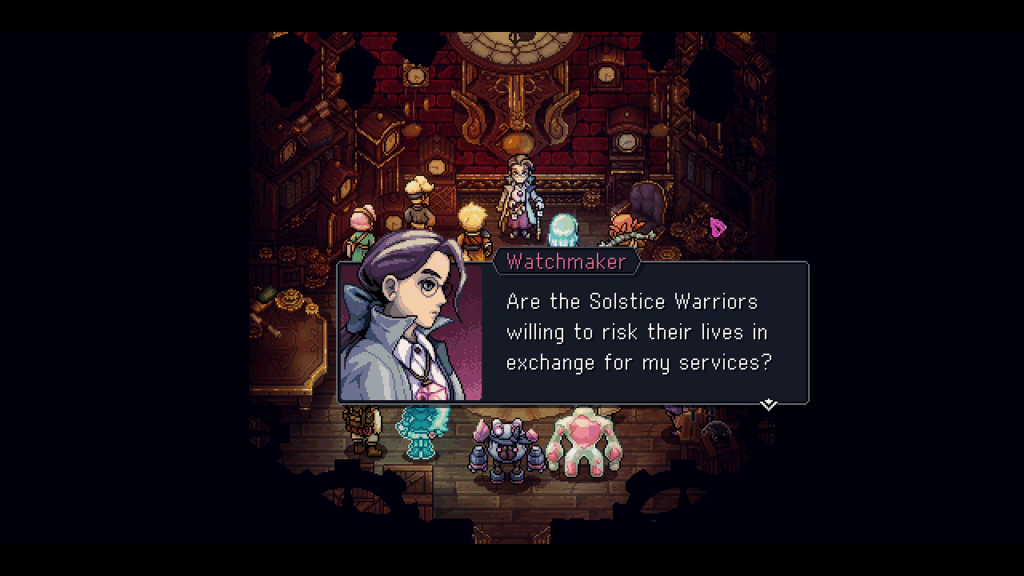
An unresolved plot thread in Sea of Stars’ story hinted that there was something curious about Keenathan, one of the pirates who ferry Solstice Warriors Valere and Zale around their oceanbound world. His identity conflict suddenly and arbitrarily becomes a crisis when I load a saved game after beating Sea of Stars’ final boss. The party visits the Watchmaker, a tertiary supporting character from the main story, to resolve the matter. The Watchmaker agrees to help Keenathan, but only if Valere and Zale help with one of her own problems first. During her collaboration with the Fleshmancer to build the Clockwork Castle, the villain infected one of her cogs with a seed of evil. When the cog was used in her masterwork, a tiny clockwork world called Horloge, the seed sprouted into a Dweller, one of the planet-consuming parasites the Solstice Warriors were created to destroy. In order to help Keenathan, Valere and Zale must enter Horloge and defeat the Dweller of Scourge, a foe unlike any they have faced before.
Knowing that Throes of the Watchmaker was due out sometime in 2025, I replayed Sea of Stars in January to refamiliarize myself with its systems. I was surprised to find many of them were retooled in 2024 by a major post-release patch called the Dawn of Equinox that significantly alters some of what I describe in my original review.
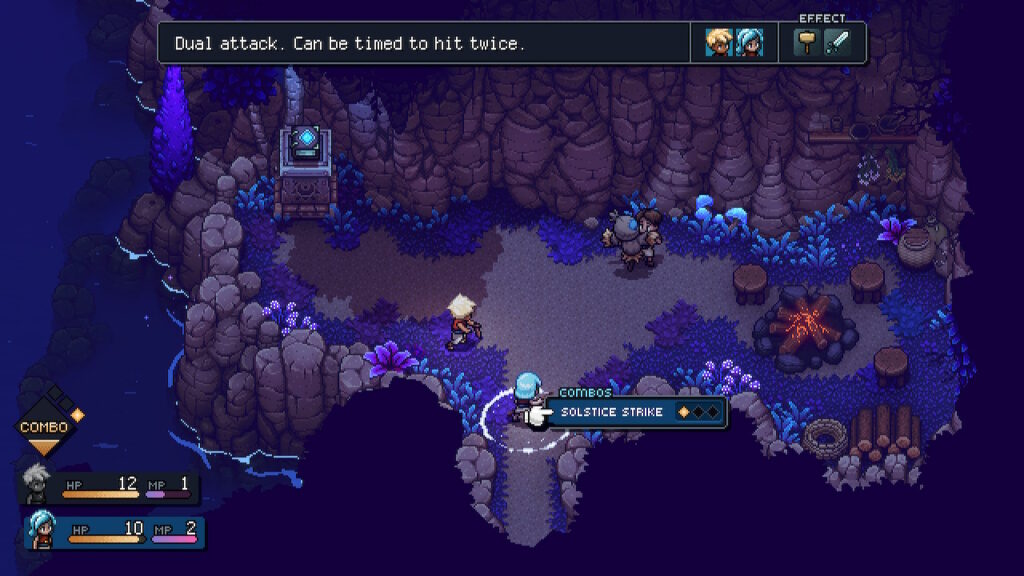
Sea of Stars now supports local cooperative play for up to three players, with each player controlling a single character both in world exploration and in turn-based combat. The two or three players even have to work together with their button presses when Combos are deployed in battle. Another major feature is a streamlined and partially rewritten prologue. It introduces combat a lot faster than the original prologue, though it still feels like a long-winded and lethargic start to Valere and Zale’s epic. Another major change is the party’s Combo points now persist between battles, making it much easier to use their Combos more often, and subsequently their Ultimate powers. Minor additions include new difficulty presets when starting a new game, new Relics that make certain systems more or less forgiving, and new animated cutscenes. Other small changes are downright funny, like removing the bewildering cap placed on cooked items the party can carry in their inventory.
I encounter Dawn of Equinox’s biggest change the first time I enter a battle. When monsters prepare to use one of their more powerful attacks, they must first charge it for several turns. During this period, a number of locks appear above their body. Each lock is inscribed with an icon indicating which party members’ attacks will break it. Breaking some of these locks weakens the ability when its charge completes. Breaking them all interrupts the ability entirely.
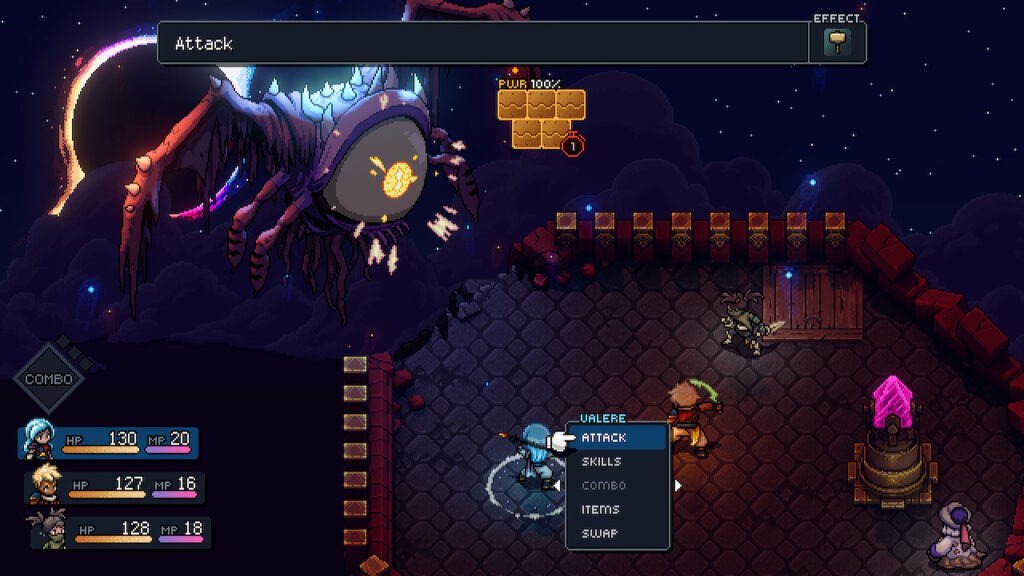
The big change from Sea of Stars’ 2023 release is the attacks needed to break locks are now hidden behind question marks. When a lock is successfully broken, the interface remembers that attack and will show the appropriate icon the next time the monster enters its charge state. This adds an extra step of experimenting with which party members are needed to interrupt enemies’ special attacks. I felt in 2023 that the combat difficulty under the original, non-hidden system could be arbitrary; it is sometimes impossible to interrupt, or even weaken, some monsters’ charged abilities, especially when they decide to use them repeatedly. Hiding the attacks that interrupt these abilities adds a new element of frustration to the process which I do not feel is to the combat’s benefit.
Those who played Sea of Stars’ original release and are returning for Throes of the Watchmaker may find this new hidden lock system an unpleasant surprise. The system may be disabled with a new Relic, though it is turned off by default. I am clearly intended to play with the locks hidden. I put up with it, but I don’t find it particularly rewarding.
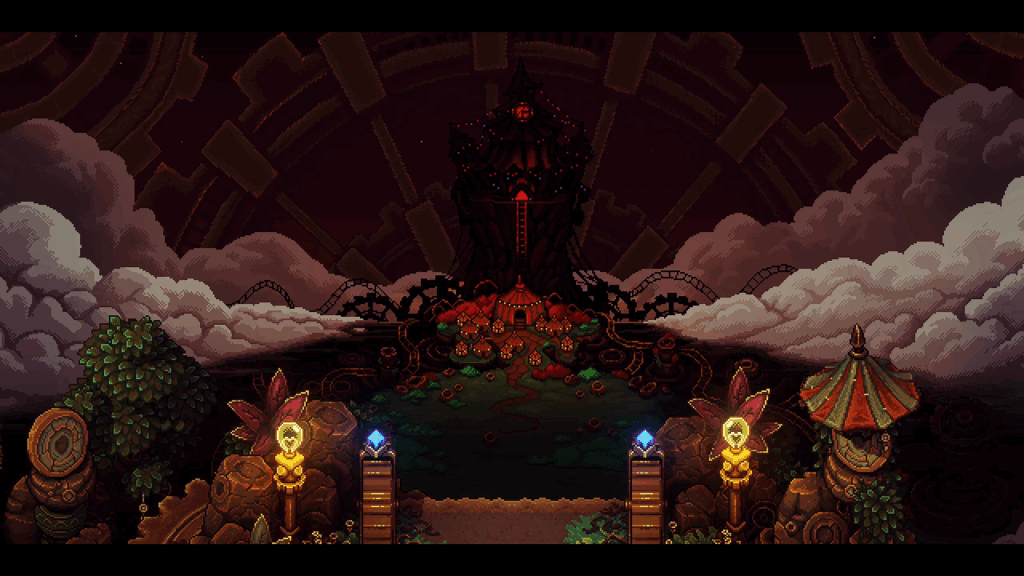
Entering the Watchmaker’s clockwork world of Horloge is like beginning a new, micro-sized RPG contained within Sea of Stars’ greater one. It is the Solstice Warrior’s world in miniature, connecting a mid-sized town with four dungeons. The adventure’s structure is broadly the same. The Solstice Warriors explore dense, pixel art environments viewed from a fixed camera angle that evokes the faux-three dimensional worlds of classic isometric RPGs. Simple platforming and sliding blocks puzzles are solved using the Mistral Bracelet and Graplou from the base campaign. Valere and Zale’s Solstice Warrior powers do not work in Horloge. Their compensation is the Mule Drone, a tiny helicopter equipped with a crane that lets the party move objects around the environment. It’s limited, but it’s better than nothing. The Watchmaker also gifts Valere and Zale with an artifact that shrinks them so they may enter her clockwork inventions, but this is an aesthetic device and has no actual function in puzzle solving.
Horloge’s visual design is Throes of the Watchmaker’s most impressive feature. Winding gears are visible nearly everywhere, spinning away in periphery shadows and supporting the land where Horloge’s people live, a constant reminder that this world is actually a clock hanging on an artisan’s wall. The idea of clockwork machinery is echoed across every element of Horloge. Its denizens are windup toys with spinning keys embedded in their backs who appear friendly and welcoming despite their faces being hidden in shadows. Valere and Zale befriend an engineer who helps them travel between Horloge’s different areas on a train that travels along the clock’s connecting machinery. It’s a pleasing environment that feels distinct in Sea of Stars’ settings without feeling wholly out of place.
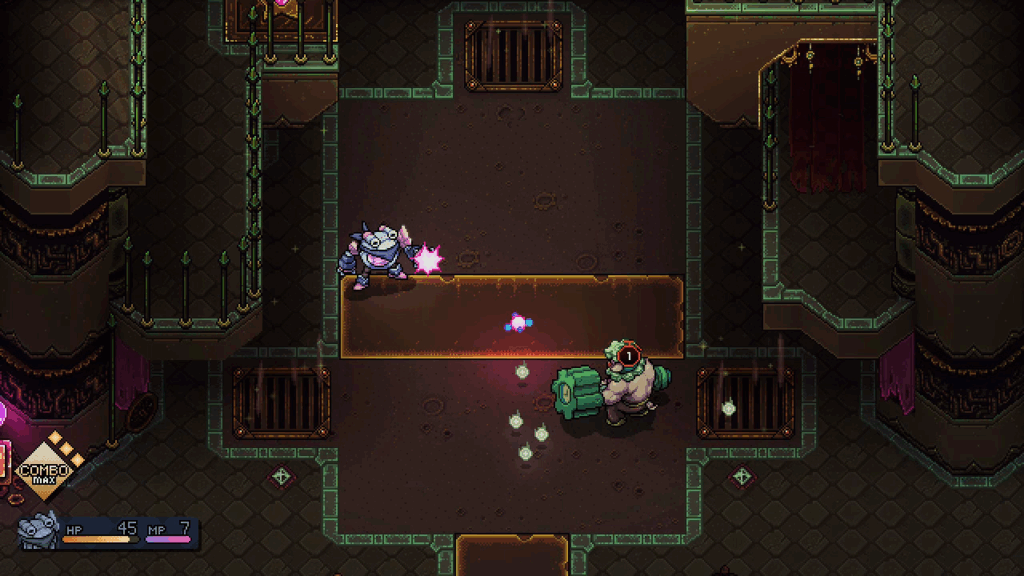
The other major addition is a new party member. The Watchmaker will not allow any of Valere and Zale’s core party members to enter Horloge, fearing what the Dweller of Scourge’s unique powers might do with them. The supporting characters are permitted to enter, allowing the pirates to take up their usual place playing music in Horloge’s inn. This leaves The Artificer, a mechanical lifeform who joins Valere and Zale late in their adventure, to unexpectedly pick up the slack as the third party member.
Arty brings some unusual twists to Sea of Stars’ typical combat. Their primary attack fires lasers from their hands. When empowered by Live Mana, instead of adding a new damage type to their basic attack, they fire additional lasers. Their Skills are a little more traditional—they essentially take Garl’s place as the party’s supporting healer—but their Cannonball Trampoline does require them to move around the screen with much more frantic energy than seen in the other party member’s Skills. At a broader level, Arty also doubles as yet another of Sea of Stars’ homages to Chrono Trigger, bearing a strong resemblance to Robo and having similar party utility.
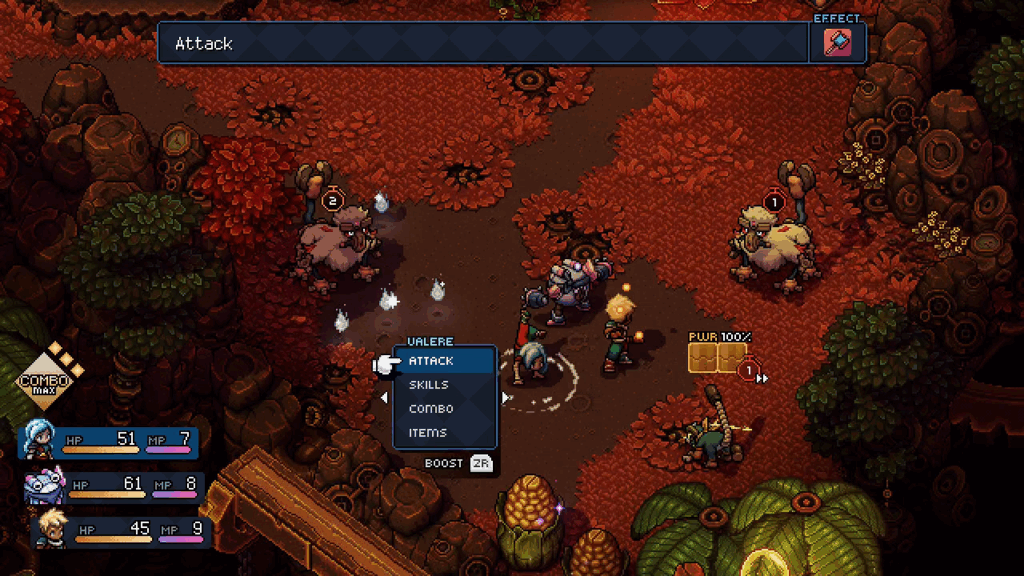
Shortly into the story, Valere and Zale discover that their Solstice Warrior powers are suppressed while inside Horloge. They are forced to adopt new roles that better reflect the Dweller of Scourge’s circussy tastes. Zale becomes a Juggler, and when I look closely at his sprite I see the clever detail that his juggling balls are tiny versions of the sunballs he conjures as a Solar Blade Dancer. Valere becomes an Acrobat. She looks ridiculous spending every battle standing on her hands, her neck craned uncomfortably forward so she can see.
With these new roles come new Skills. Zale continues to have the party’s most resource-efficient healing Skill, but now instead of healing his friends with magical sunlight, he throws a pie in their face or boomerangs one into his own to heal himself. Valere’s Acrobat feels like it undergoes a more dramatic transformation from her Lunar Monk class. Her Skills let her damage the enemy party while healing her own by limboing beneath red and blue poles—yes, really—and swinging on a trapeze to deal focused damage to a single foe.

New Skills means the party’s Combos are also different. The biggest impact from this change is the party no longer has access to Mending Light, the powerful healing Combo I abuse to excess in the base adventure. I like this change. It encourages me to use more of the party’s Combos instead of saving all their points for a free heal every few turns.
Despite these major changes to Sea of Stars’ battle systems, overall combat in Horloge feels like a reduction. Experience levels are greatly simplified. Valere, Zale, and Arty essentially revert to level 1 when they enter Horloge and can only work back up to level 6, or Renown level 6 as it is renamed. Their statistics auto-allocate when they level up, removing my ability to weigh an individual character’s performance in a specific direction and resulting in a uniformity between every player’s party. The comparatively few experience levels means combat difficulty swings rapidly as the party levels up. What was a challenging battle the party can barely overcome becomes trivial when they level up, skyrocketing their statistics past what that fight is balanced for in an instant.
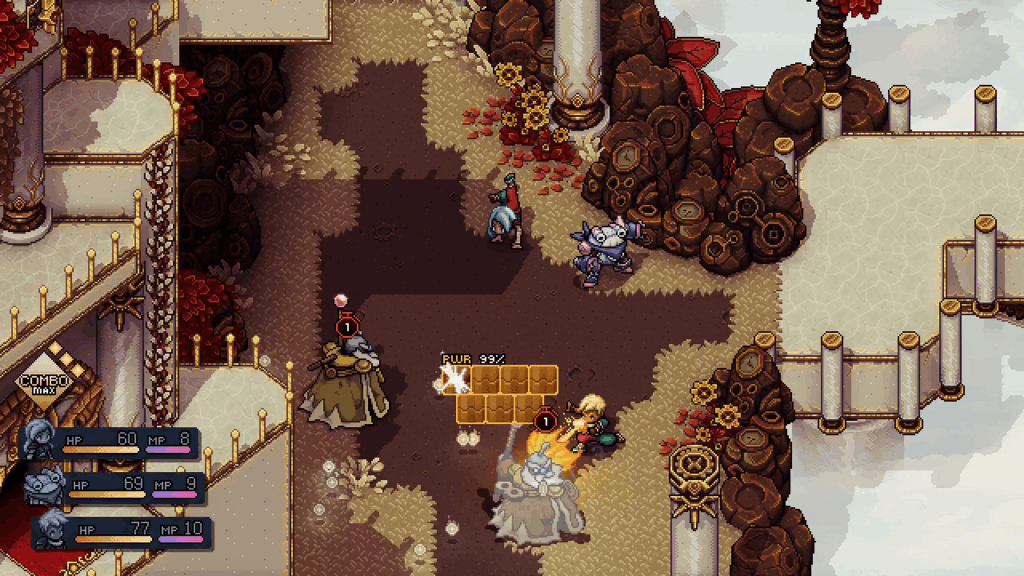
Attack types are also reduced from six to four: Bonk, Laser, Fire, and Magic. Of these four, only Bonk is shared between all three characters, which can make breaking locks troublesome if a character is knocked unconscious or is otherwise unavailable. Magic-type damage is particularly difficult since Valere requires live mana, a Skill, or a Combo to deal it, meaning there are sometimes occasions where the party lacks the resources to deal that type of damage at all. In Sea of Stars, I feel the difficulty of breaking locks and interrupting enemy attacks could feel arbitrary. Throes of the Watchmakers’ reduced number of attack types takes the systems that cause those feelings and make them acute.
As a retro RPG, Throes of the Watchmaker makes changes to Sea of Stars’ combat that are interesting but not wholly successful at equaling or surpassing the base videogame. It’s how it uses its themes and characters that it is wholly a disappointment.
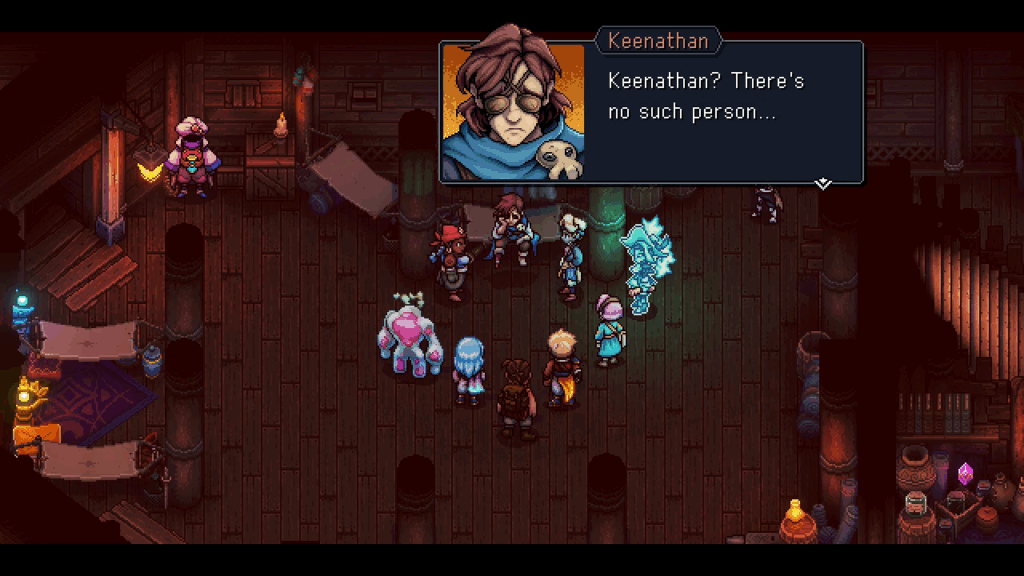
If I were compelled to make a criticism of Sea of Stars’ core story and characters, it would be that they are overly reverent to the videogames they homage. Many of its ideas are spins on those that appear in classic 16-bit RPGs—Chrono Trigger in particular—so they are not original. This does not mean that they are not well-made, compelling, or exciting. There’s a consistent level of quality in the base videogame to which other retro RPGs can only aspire. Throes of the Watchmaker is another matter. It’s a hodgepodge of half-formed ideas and a collision of unresolved plot points that never coalesce into a unifying idea.
The problems start with Keenathan. The stakes of his conflict are never clearly started. I am never given an understanding of why his problem is a problem or what will happen if it is not resolved. It serves only to bring the party back to the Watchmaker, a suggestion brought up from nowhere by Teaks, the party’s traveling historian. Once the Watchmaker reveals there’s another Dweller loose inside Horloge, Keenathan’s conflict is almost totally forgotten—until the resolution, when the plot seems to be under the impression that something significant has happened when the Watchmaker honors her agreement with the Solstice Warriors. Keenathan’s and the Watchmaker’s conflicts have nothing to do with each other. They are mismatched ribbons tied around an ill-fitting package, forced together with tape but not with art or intention to bring Valere and Zale to Horloge’s doorstep.

The Dweller of Scourge’s circus theming is inexplicable. The Watchmaker explains to the party that Horloge will force them to face “reflections” of their “darker traits.” This is the best explanation for the circus. The Dweller of Scourge created themselves as the Watchmaker’s reflection. The Watchmaker is a taciturn and practical person, so the Dweller of Scourge creates as her reflection the Puppeteer, a sadistic carnival barker who rules over an evil circus. This theme seems to have been chosen because an evil circus is the most obvious reflection of the Watchmaker’s orderly and peaceful Horloge. It’s also a lazy cliché, and however much Sea of Stars indulges in cliché, it has never been lazy about them.
This poorly imagined concept of reflections is further exploited with Valere and Zale. Shortly after entering Horloge, their Solstice Warrior powers are extracted and used to create their own dark reflections. Valere’s twin is the arrogant Feral Queen and Zale’s is the vain Narcis King.
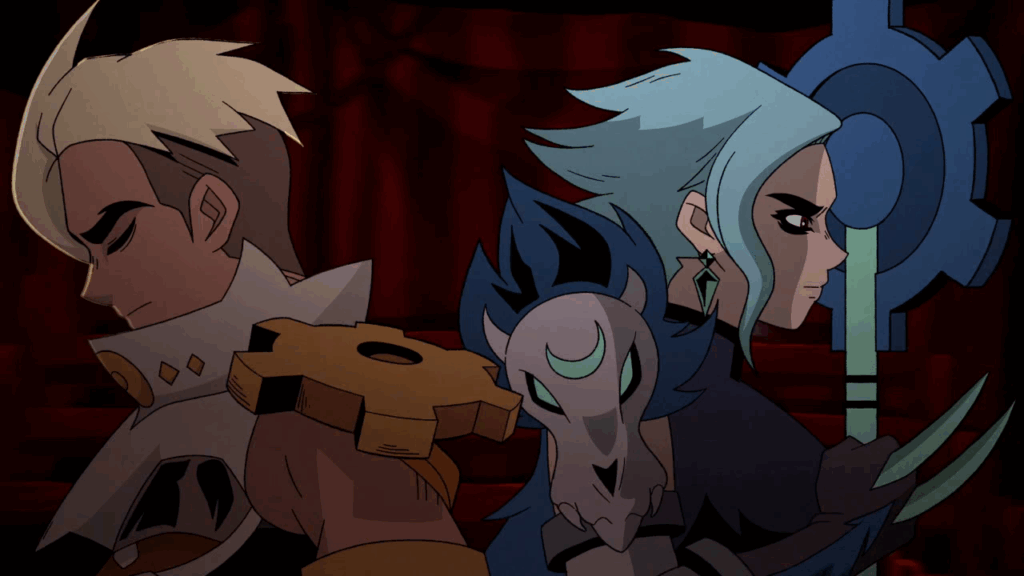
These reflections do not work.The Feral Queen is meant to reflect Valere’s self discipline. The Narcis King is meant to reflect Zale’s selflessness. The trouble is these ascribe personality traits to Valere and Zale that simply do not exist. A criticism I made in my original Sea of Stars review is the Solstice Warriors have bland personalities. Their dark halves try to fix this by retroactively applying depth to them. It isn’t convincing and makes their previous lack of distinct personalities stand out all the more.
Throes of the Watchmaker fumbles its plot hard. It begins with confusion, unfolds with cliché and unfounded character nuance, and concludes with a resolution whose meaning is never clarified. It’s all the more disappointing because of the incredible RPG it’s attached to.
The events inside Horloge are self-contained. Valere and Zale cannot use their new classes outside Horloge, nor may Arty join them in their ultimate battle against the Fleshmancer. The only skill they may take with them outside the DLC is a new Combo attack. It’s a souped up version of their basic Solstice Strike, the very first Combo they ever learn, unimaginatively dubbed the Super Solstice Strike. It does not excite and does not feel like an especially potent weapon against foes outside Horloge.
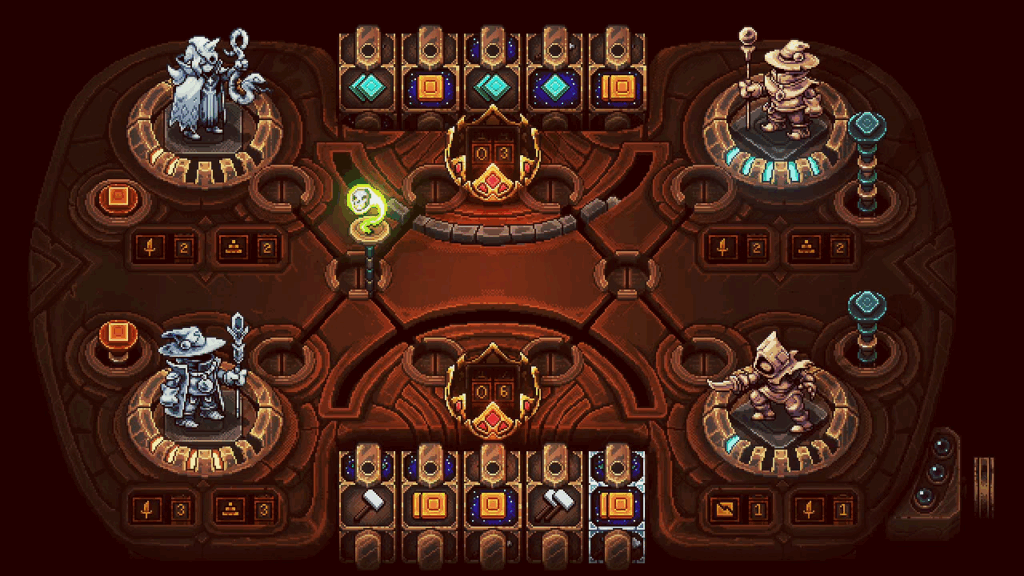
There are a few extra things to do around Horloge if I wish to take the time to fully explore it with Valere and Zale. The Wheels minigame returns. I hope it will be given new depth. It is given a new figurine, the Warlock, which attacks multiple times in a single turn at the cost of also damaging the player’s health. All four of the new Wheels champions may still be easily defeated by pouring every resource into the Mage figurine every turn. Despite returning to this interesting-but-flawed minigame, Throes of the Watchmaker makes no effort to rebalance it to create depth and challenge.
The other major side activity is fixing up a broken clock found in the center of Horloge. Twelve stones are hidden across all of Horloge’s areas. Finding them all opens a new door. I hope to encounter a challenging bonus boss inside, the greatest foe the Solstice Warriors will ever face, who might reward them with a powerful new weapon upon its defeat. Instead I get more vague allusions to The Messenger. Only the relative ease of opening this door keeps it from feeling like a total letdown.
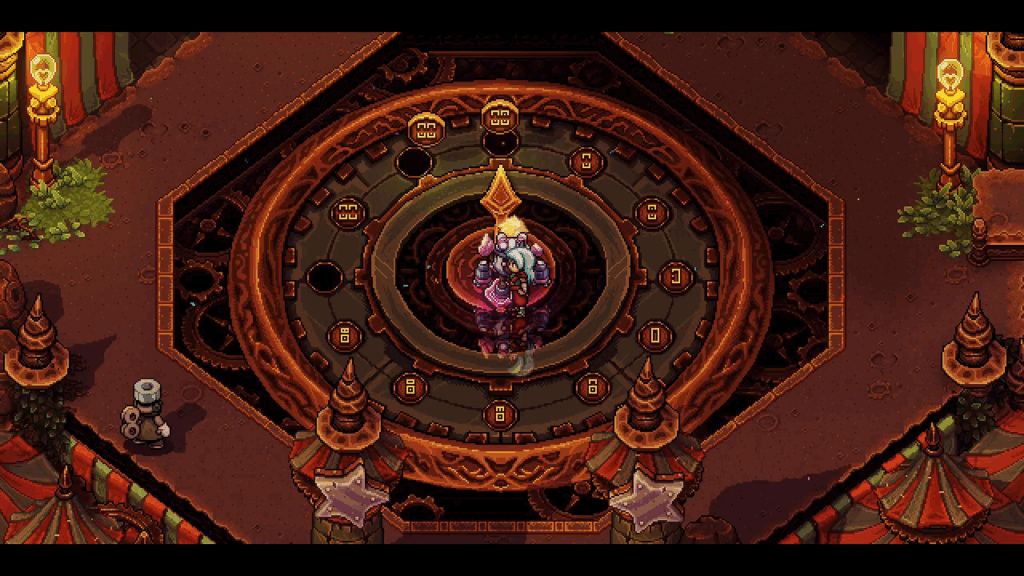
Throes of the Watchmaker is a disappointing but blessedly inconsequential addition to one of 2023’s best videogames. While the new classes and party member have promise, the DLC’s comparative brevity keeps their potential from being fully realized. The events that bring the party to Horloge feel contrived and the story and characters found inside it are weary clichés. It’s difficult to be too frustrated with a free addition to a videogame, and Throes of the Watchmaker by no means lessens Sea of Stars’ overall excellence. I only wish it added to it.